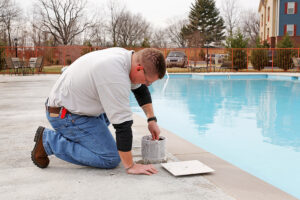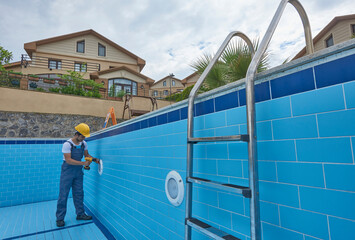If you are having trouble with your pool, it may be time to think about Pool Repair. After all, you don’t want your pool to be destroyed by one bad day. Listed below are some common problems with pools and tips to fix them. Using one of these solutions will ensure your pool stays safe and beautiful for years to come. And remember, the best way to fix your pool is to prevent it from happening again.
First, check for excessive chlorine levels. When a swimming pool has too much chlorine, you could experience rashes or red eyes. Worse, your bathing suit might also fade over time. To fix the problem, buildings can install computerized chemical controllers. These devices cost about $7,000, but they prevent pool closures. A swimming pool repair professional can help you fix the problem and avoid future damage to your pool. However, if you suspect your swimming pool is too much chlorine, contact the building’s maintenance department to ensure that your pool is safe and secure.
The cost of Pool Repair varies greatly and depends on several factors. The type of pool, size, and equipment are all factors. Prices are typically quoted per square foot or per linear foot. The size of the pool will also determine the cost of the repairs. Above-ground pools tend to cost less than in-ground ones, while fiberglass pools require more time to repair. However, the most difficult types of pool repair are those made of concrete.
If you are unable to identify the problem, you can call a pool repair service. If you suspect a major leak, the service team will inspect the pool and fix it. Although some DIY tips may be tempting, professional help is best. Many people try to fix pool leaks on their own, but this could only lead to further problems and cost you more money. So, before calling for a Pool Repair service, make sure that you understand the process.
Whether you want to replace an entire part of the pool or fix a single faulty piece, swimming pool repairs are essential for the health of your pool. If you have a leak or some rust, call a pool repair service to repair it. This is much cheaper than purchasing a new swimming pool. So, when you need to fix your pool, hire a pool repair company that specializes in concrete pools. It’s the best way to ensure the safety of your pool, and it won’t break the bank!
The cost of fixing a small leak on a gunite pool liner costs about $300 to $500. But a larger leak in a fiberglass pool can cost as much as $700. Even if you’re not a DIY guy, a pool repair company can make you look like a pro for under $20. If you’re a serious DIYer, the price of fixing a large hole in a concrete pool may reach $2000.
If you have a fiberglass pool, you’ll want to have it cleaned regularly to prevent algae. While fiberglass pools are strong and durable, they can develop discoloration in the plaster. If this happens, acid washing is an excellent way to fix the problem. Acid washing is a quick way to remove the discolored plaster and restore the original look of your pool. The process is easy, but you need professional training for it, and a pool repair expert should know how to do it properly.
The cost of pool repair services varies, but you should know that an average service will charge about $250 for opening and closing your pool. Weekly cleaning will cost around $40 and can range up to $150, depending on the size and condition of your pool. You can also opt for a weekly cleaning service for about $20 to $40 per month. Regular pool maintenance will help you to limit the number of repairs. A professional will clean your pool regularly, empty skimming baskets, and vacuum it. You should also check it frequently to identify signs of trouble early on.
Another option for a pool repair is a DIY repair. Do-it-yourself repair methods may result in a larger crack, which will cost you more money. So, if you have the skills, do it yourself, but be careful. Most common mistakes in pool repair are avoidable. Injecting a polyurethane or epoxy into the crack isn’t a long-term solution. Hydraulic cement is another option, but it’s temporary and doesn’t address the root cause of the problem.

